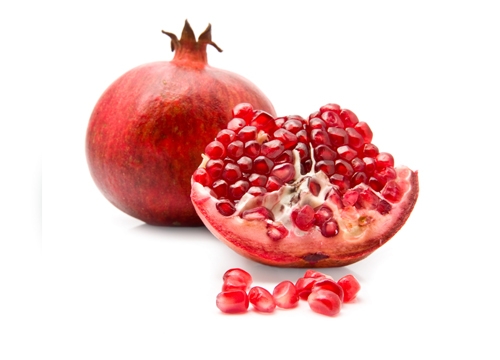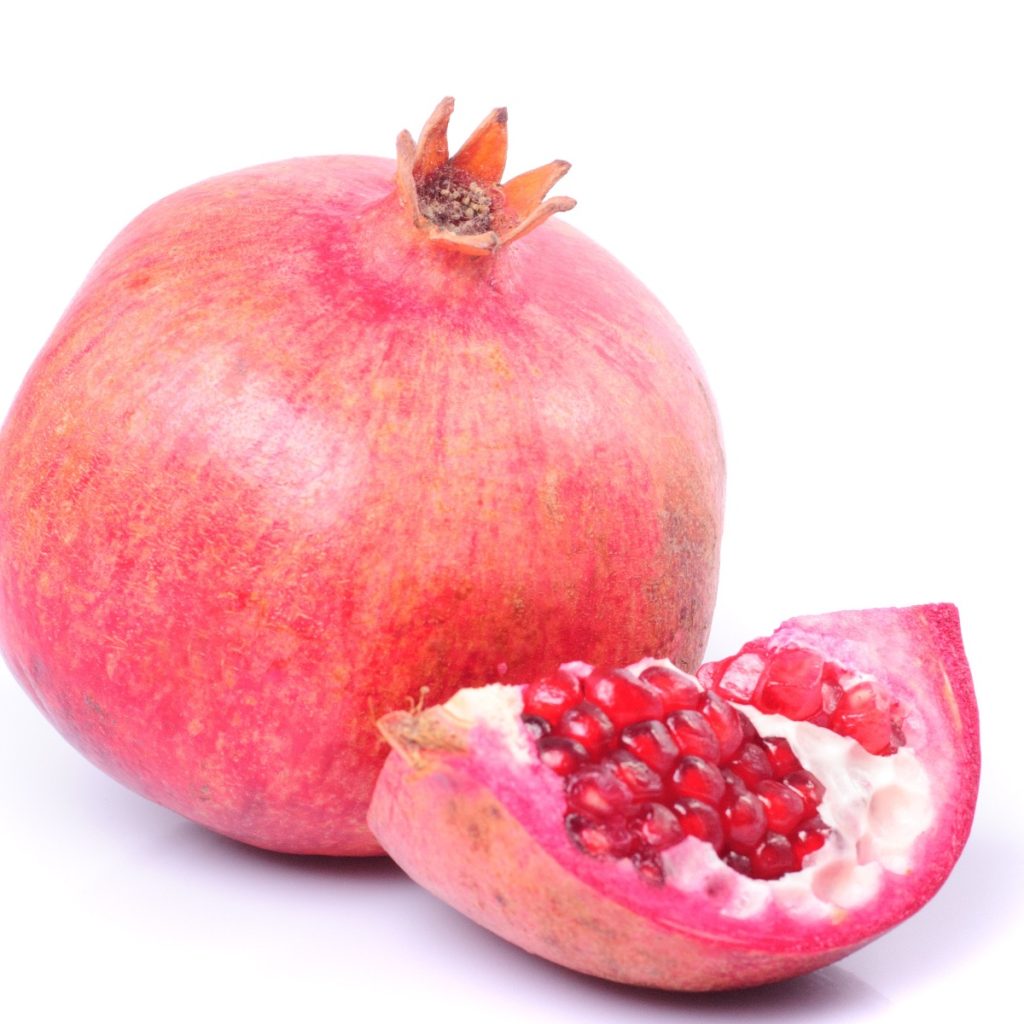What are Pomegranates and How Are They Used In Cooking?
What Does A Pomegranate Look Like?
The pomegranate is one of those fruits that everyone has heard of, but few have tried. From the outside, it does not always look particularly appealing. Although the skin, when ripe, takes on a deep ruby color rarely rivaled in nature, it is thick, tough, and somewhat daunting to combat. Like so many things in life, however, the rewards of getting to know this delightful and exotic fruit are vast.
The pomegranate is unlike any other fruit. Although it is similar in size to orange, its shape is an odd combination of a sphere and a hexagon, with a prominent calyx on one end. The reason behind this somewhat complex shape is the brilliant pattern of seeds inside the thick husk. A pomegranate, when opened, reveals a dense collection of seeds nestled among a whitish, spongy pulp.
Are They Edible?
Although the pomegranate’s pulp is edible, the seeds are a real treat. Each seed is individually encased in a crimson-colored sac.
The juice of this sac provides the tart taste and the deep red color consumers find in the variety of juices and pomegranate-based products currently on the market.
If not eaten carefully, this same juice can stain fingers reddish-purplish—a telltale sign that the pomegranate’s allure has once again proven too strong. Overall, the seeds and their encasings account for about half of the pomegranate’s weight.
Depending on the variety and degree of ripeness, the pomegranate seeds can vary in taste from a little sour (similar to ripe cherries) to fairly sharp (similar to uncooked cranberries). They can be enjoyed straight by eating the seeds, in any of several pomegranate-derived goods, or as a juice.
Those with milder tastes often find the commercially available juice blends more palatable than straight pomegranate juice, which can be fairly robust.
Pomegranate as a Super Fruit

The recent explosion of interest in the pomegranate is largely due to its recent classification as a “super fruit.” As the name suggests, superfruits are typically more in demand than garden-variety bananas and apples. By definition, super fruits are exotic fruits with higher than average antioxidants, nutritional content, and success with modern consumers.
The pomegranate fulfills each of these categories and has even been featured in a number of scientific studies for its ability to combat the aging process. The pomegranate has become so popular of late that it has even surpassed the blueberry, America’s once-favorite super fruit, in terms of popularity.
Though originally from the Middle East, pomegranates are now commonly grown in California and its mild-to-temperate climactic equivalents. The varieties out of California are typically available in most specialty stores (and even in many chain grocery stores) at their peak of productivity between September and January.
Pomegranates grow on bushes that can reach heights of 50 feet, although most commercial varieties are much kinder on their cultivators, reaching an average height closer to 10 and 20 feet.
Pomegranates are considered by many to be a pretty tough and ancient breed. The bushes can grow to considerable heights and live for hundreds of years (even though the best fruits are typically only produced in the first few decades of the pomegranate bush’s long life). Pomegranates are also known for their ability to withstand lengthy droughts; climates with too much moisture during the ripening season can cause damage to the roots and fruits.
The Myth Behind Pomegranates
Further contributing to their aura of antiquity is their appearance in several historical and mythological tales. Its origin lies in the ancient lands of Afghanistan and the Mediterranean, and it has been enjoyed in cooking and medicine throughout the Middle East for centuries.
In Iran, juicing the pomegranate is an enjoyable household chore. In Italy, opening the pomegranate—a task that many consider the major barrier to enjoying this delightful fruit—is considered a means of social interaction. It’s no wonder that people have been interested in this fruit long before American consumers got wind of its incredibly delicious and healthful properties.
The History of Pomegranates

Pomegranates, also called the “fruit of paradise,” are one of the “hot” ingredients these days. You hear about them in all the cooking magazines and on cooking shows. How long they will be “in” is anybody’s guess, but for now, they are, and they do make a great addition to many recipes.
The History of the Pomegranate
Depending on where you look for information, pomegranates might be called the “fruit of the underworld,” the “fruit of paradise,” or more simply, the “seeded apple.” Those who prefer the more exotic names will likely revere the fruit for its inherent link to sensuality.
One look at the hundreds of glistening crimson seeds inside each pomegranate, and it’s no wonder why people have been associating them with fertility for thousands of years. Just a single taste of the pomegranate has often been considered enough to tempt even the gods and goddesses into extraordinary actions.
Shrouded in mystery and centuries of folklore, the pomegranate is one of the most revered fruits. Tales of pomegranates,” whether found in Greek myths, Biblical texts, or ancient manuscripts,” are spread worldwide. No country or culture has been able to evolve without at least a passing reference to this exotic and delicious fruit.
Early History
Pomegranates have been on the tables and serving platters of ancient Egyptians and Arabs for millennia. They originated in Persia, but from the earliest known references, they were commonly found in the surrounding areas of Georgia, Armenia, and other Mediterranean lands.
China also figures prominently as one of the early aficionados of the pomegranate; the fruit’s origins there can be traced back to 100 BC.
Although the earliest pomegranate bushes grew wild and uninhibited throughout the Middle East, they have long been cultivated for sale and personal use. Armenia, in particular, has a detailed history of interaction with the pomegranate, with actual fossilized remains evident from as far back as 1000 BC.
The nation congratulates itself on its lengthy and sincere devotion to the pomegranate. This stamp of approval is important for even the most exacting fruit critics, as Armenia is known for its many exotic and delicious fruits.
Their Worldwide Journey
As the pomegranate grew in popularity and use, it spread to other lands and civilizations. Its introduction was almost always met with enthusiasm. Its preserved remains have even been found in the excavated tombs of ancient Egyptians, so sure were they that no journey to the hereafter was complete without this enchanting fruit.
Wherever they traveled, it was adopted and renamed. They figured prominently in the banquets of Indian royalty and accompanied Arab traders as they made their way throughout the Middle East, enticing merchants and members of the higher classes.
Romans called it the “Punic apple” and cultivated it extensively. When it was brought to Spain around 800 AD, it became the national emblem and was the basis for naming the city of Granada (derived from the pomegranate’s Spanish name).
Some tales even link the term “grenade” to the pomegranate. The eighteenth-century French compared the spreading of the pomegranate’s seeds with the scattering of debris from the weapon’s explosion.
In comparison to the pomegranate’s antiquity, it wasn’t until fairly recently that the pomegranate made its way to the Americas. It came in the wake of the conquistadors of Spain, spreading throughout the United States alongside Jesuit missionaries and other cultivators.
It has since become most popular in the South and in California, where the climate and the love of all things delectable have worked enormously in the pomegranate’s favor.
The Pomegranate’s Fame
The pomegranate has even been extolled by history’s most beloved legends and written works. Ancient Greeks used pomegranate in a number of mythological tales. The Bible refers to it numerous times; some even believe the forbidden fruit of the Garden of Eden was a pomegranate.
This idea is reinforced by the pomegranate’s long-held association with fertility and sensuality. Chaucer, Homer, and Shakespeare are also devoted to its enigma, as the fruit figures in The Canterbury Tales, The Odyssey, and Romeo and Juliet.
No matter when or where the pomegranate was first encountered, almost all cultures have enjoyed its tart, jeweled seeds, and numerous culinary and medicinal uses. It has been a time-honored traveler for thousands of years: the main attraction for royal dining, enticing others into temptation, and a companion for the afterword.
It’s no wonder this colorful fruit continues to gain popularity and consumption.













2 Responses
the seeds in my pomegranate tree are very tart. I have eaten fruit that is sweet. Is this typical if some varieties or do I need to fertilize improve the sweetness?
The tartness of your pomegranate seeds could be due to the variety you have, as some naturally produce more acidic fruit. Varieties like ‘Wonderful’ tend to be more tart, while ‘Angel Red’ or ‘Eversweet’ are known for their sweetness.
However, soil conditions, watering, and fertilization can also impact sweetness. Ensure your tree gets enough potassium and phosphorus, which help with fruit development. Too much nitrogen can lead to lush growth but less sweet fruit. Also, allowing fruit to fully ripen on the tree before harvesting can improve sweetness.